Question: how to force geom_density to start in (0,0)?
I have produced this plot:
Using this code (inputs on how to improve the script, are welcome):
ki60low <- subset(p, p$ki67in==0 & p$recurrence==1)
ki60in <- subset(p, p$ki67in==1 & p$recurrence==1)
ki60high <- subset(p, p$ki67in==2 & p$recurrence==1)
ki60low$time.recur.months1 <- ki60low$time.recur.months/12
ki60in$time.recur.months1 <- ki60in$time.recur.months/12
ki60high$time.recur.months1 <- ki60high$time.recur.months/12
theme <- theme(axis.line = element_line(colour = "black"),
panel.grid.major = element_line(colour = "gray98"),
panel.grid.minor = element_line(colour = "gray98"),
panel.border = element_blank(),
panel.background = element_blank())
ggplot() + theme +
scale_x_continuous(name="Years to recurrence", breaks=c(0,1,2,3,4,5,6,7,8,9,10,11), labels=c("0","1","2","3","4","5","6","7","8","9","10","11"), limits=c(-1,11)) +
scale_y_continuous(name="Number of recurrences", limits=c(0, 6), seq(0,6,by=1)) +
geom_bar(aes(x=ki60low$time.recur.months1), colour="#1C73C2", fill="#1C73C2", alpha=0.2) +
geom_bar(aes(x=ki60in$time.recur.months1), colour="red", fill="red", alpha=0.2) +
geom_bar(aes(x=ki60high$time.recur.months1), colour="black", fill="black", alpha=0.7) +
geom_density(aes(x=ki60low$time.recur.months1, y=..count..), colour="#1C73C2", fill="#1C73C2", alpha=0.1) +
geom_density(aes(x=ki60in$time.recur.months1, y=..count..), colour="red", fill="red", alpha=0.1) +
geom_density(aes(x=ki60high$time.recur.months1, y=..count..), colour="black", fill="black", alpha=0.18) +
annotate("label", x = 8.28, y = 5.5, label = "Ki-67 proliferative index: 0 - 4%", label.size = 0.5, cex=8, colour="#1C73C2") +
annotate("label", x = 8.28, y = 4.5, label = "Ki-67 proliferative index: 5 - 9%", label.size = 0.5, cex=8, colour="red") +
annotate("label", x = 8.28, y = 3.5, label = "Ki-67 proliferative index: \u226510% ", label.size = 0.5, cex=8, colour="black") +
theme(axis.text.x = element_text(color = "grey20", size = 12), axis.title.x = element_text(color = "grey20", size = 14, face="bold", margin=margin(t=12))) +
theme(axis.text.y = element_text(color = "grey20", size = 11), axis.title.y = element_text(color = "grey20", size = 14, face="bold", margin=margin(r=12))) +
theme(legend.text=element_text(size=12)) + theme(legend.title=element_text(size=14))
I would like the geom_density to start in (0,0). How can this be done? I found this, which did not help.
My data p
p <- structure(list(ki67in = c(0L, 2L, 0L, 0L, 1L, 0L, 2L, 2L, 1L,
0L, 1L, 2L, 0L, 2L, 0L, 1L, 1L, 1L, 0L, 2L, 2L, 0L, 1L, 1L, 0L,
0L, 0L, 1L, 0L, 1L, 2L, 0L, 1L, 1L, 0L, 1L, 0L, 1L, 0L, 0L, 0L,
0L, 0L, 0L, 0L, 1L, 0L, 1L, 0L, 0L, 0L, 0L, 0L, 0L, 1L, 0L, 2L,
1L, 0L, 0L, 0L, 0L, 0L, 0L, 0L, 0L, 2L, 0L, 0L, 1L, 0L, 1L, 0L,
0L, 1L, 0L, 0L, 1L, 2L, 0L, 0L, 0L, 0L, 1L, 0L, 0L, 0L, 0L, 0L,
0L, 0L, 0L, 0L, 0L, 0L, 0L, 0L, 0L, 1L, 0L, 0L, 0L, 0L, 0L, 1L,
0L, 0L, 1L, 1L, 2L, 0L, 2L, 0L, 0L, 1L, 0L, 0L, 0L, 0L, 0L, 0L,
1L, 0L, 2L, 1L, 0L, 0L, 0L, 0L, 0L, 0L, 0L, 0L, 1L, 0L, 0L, 2L,
0L, 0L, 0L, 0L, 1L, 1L, 0L, 0L, 0L, 0L, 0L, 0L, 0L, 0L, 1L, 0L,
0L, 0L, 0L, 0L, 0L, 0L), time.recur.months = c(0.75, 0.6, 4.665297741,
0.1, 0.75, 1, 2, 2, 2, 3, 3, 3, 3, 4, 4, 4, 4, 5, 6, 7, 8, 8,
8, 9, 11, 12, 13, 13, 15, 15, 15, 16, 17, 17, 18, 27, 28, 29,
30, 33, 34, 35, 37, 37, 38, 39, 40, 41, 45, 49, 49, 50, 52, 53,
54, 56, 56, 56, 56, 57, 58, 58, 60, 60, 60, 60, 61, 62, 63, 64,
66, 67, 67, 72, 72, 74, 78, 80, 80, 80, 81, 82, 83, 83, 84, 84,
85, 85, 86, 86, 88, 88, 88, 88, 89, 89, 89, 90, 90, 91, 91, 92,
92, 92, 92, 93, 93, 93, 93, 93, 93, 94, 97, 98, 98, 99, 99, 99,
100, 101, 101, 101, 103, 103, 103, 103, 104, 104, 106, 106, 109,
110, 111, 111, 112, 114, 114, 115, 116, 117, 118, 118, 118, 119,
120, 120, 120, 120, 120, 120, 121, 121, 123, 124, 124, 125, 125,
125, 125), recurrence = c(0L, 0L, 0L, 0L, 0L, 0L, 1L, 0L, 0L,
0L, 1L, 0L, 0L, 1L, 0L, 1L, 0L, 1L, 1L, 1L, 1L, 1L, 1L, 1L, 0L,
1L, 0L, 0L, 1L, 0L, 0L, 0L, 0L, 1L, 0L, 0L, 0L, 0L, 0L, 0L, 0L,
0L, 0L, 0L, 1L, 1L, 0L, 0L, 0L, 1L, 0L, 0L, 0L, 1L, 1L, 0L, 1L,
0L, 0L, 1L, 1L, 1L, 0L, 1L, 0L, 0L, 0L, 0L, 0L, 0L, 0L, 0L, 0L,
0L, 0L, 1L, 0L, 0L, 0L, 0L, 0L, 0L, 0L, 0L, 0L, 0L, 0L, 0L, 0L,
0L, 0L, 0L, 0L, 0L, 0L, 0L, 1L, 1L, 0L, 0L, 0L, 1L, 0L, 0L, 0L,
0L, 0L, 0L, 0L, 0L, 0L, 0L, 0L, 0L, 0L, 0L, 0L, 0L, 0L, 0L, 0L,
0L, 0L, 0L, 0L, 0L, 0L, 0L, 0L, 0L, 0L, 0L, 0L, 0L, 0L, 0L, 0L,
0L, 0L, 0L, 0L, 0L, 1L, 0L, 0L, 0L, 0L, 0L, 0L, 0L, 0L, 0L, 0L,
0L, 1L, 0L, 0L, 0L, 0L)), class = "data.frame", row.names = c(1L,
2L, 3L, 9L, 10L, 11L, 12L, 13L, 14L, 15L, 16L, 18L, 19L, 20L,
21L, 22L, 23L, 24L, 25L, 26L, 27L, 28L, 29L, 30L, 31L, 32L, 33L,
34L, 35L, 36L, 37L, 38L, 39L, 40L, 41L, 44L, 45L, 46L, 47L, 48L,
49L, 50L, 51L, 52L, 53L, 54L, 55L, 57L, 59L, 60L, 61L, 62L, 63L,
64L, 65L, 66L, 67L, 68L, 69L, 70L, 71L, 72L, 73L, 74L, 75L, 76L,
77L, 78L, 79L, 80L, 81L, 82L, 83L, 84L, 85L, 87L, 89L, 90L, 91L,
92L, 93L, 94L, 96L, 97L, 98L, 99L, 100L, 101L, 102L, 103L, 104L,
105L, 106L, 107L, 109L, 110L, 111L, 112L, 113L, 114L, 115L, 116L,
117L, 118L, 119L, 120L, 121L, 123L, 124L, 125L, 126L, 127L, 128L,
130L, 131L, 132L, 133L, 134L, 135L, 136L, 137L, 138L, 139L, 140L,
141L, 142L, 143L, 144L, 145L, 146L, 147L, 148L, 149L, 150L, 151L,
152L, 153L, 154L, 155L, 156L, 157L, 158L, 159L, 160L, 161L, 162L,
163L, 164L, 165L, 166L, 167L, 168L, 169L, 170L, 171L, 172L, 173L,
174L, 175L))

